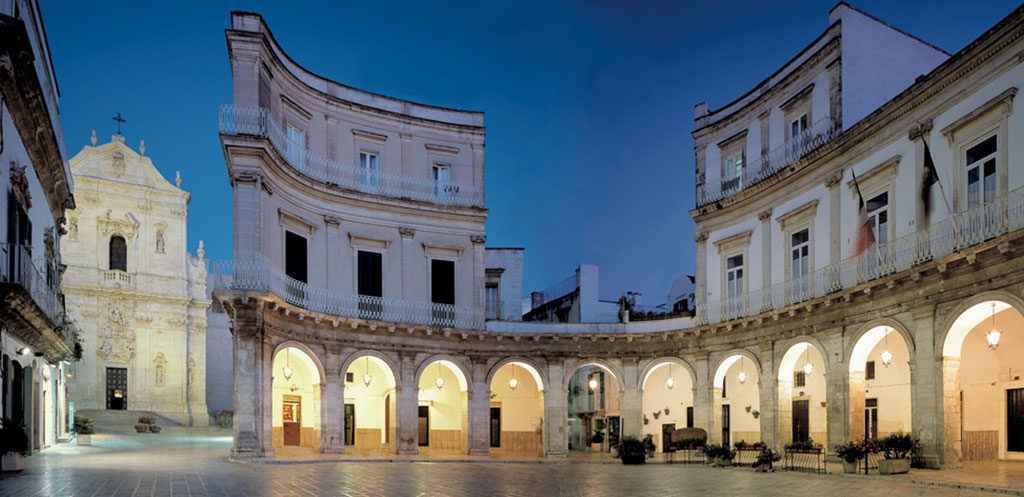

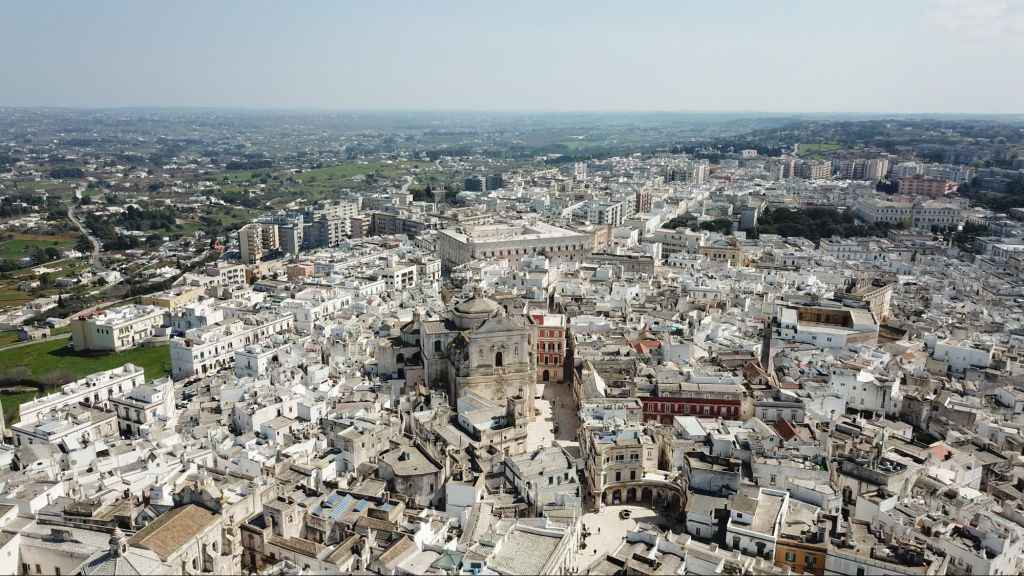


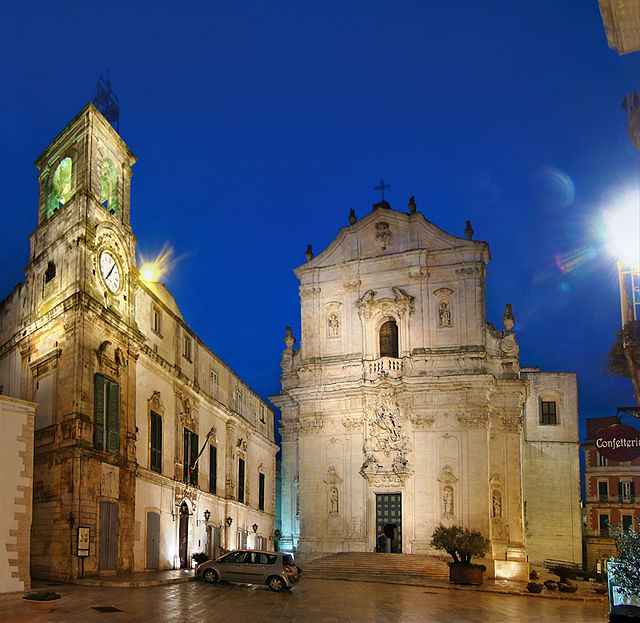 The urban center of Martina Franca stands in a dominant position over the valley, at 431 meters above sea level, from which you can admire the red earth of the Murgia dei Trulli, dotted with tens of thousands of trulli, from sumptuous farmhouses of ancient agro vocation -silvo-pastoral and by the sinuous and orderly lattice of dry stone walls. A medieval document of 1260 mentions, among the numerous toponymic boundaries, the Castrum Martinae, probably a military installation, perhaps a tower with essential fortifications, lying in the territory of Taranto, city faithful to Manfredi; the castrum insisted on a height dominating the Valle d'Itria, at the time almost entirely part of Monopoli territory. The castrum occupied a small portion of the current historic center of Martina Franca, namely the Montedoro and Curdunnidde districts.
The urban center of Martina Franca stands in a dominant position over the valley, at 431 meters above sea level, from which you can admire the red earth of the Murgia dei Trulli, dotted with tens of thousands of trulli, from sumptuous farmhouses of ancient agro vocation -silvo-pastoral and by the sinuous and orderly lattice of dry stone walls. A medieval document of 1260 mentions, among the numerous toponymic boundaries, the Castrum Martinae, probably a military installation, perhaps a tower with essential fortifications, lying in the territory of Taranto, city faithful to Manfredi; the castrum insisted on a height dominating the Valle d'Itria, at the time almost entirely part of Monopoli territory. The castrum occupied a small portion of the current historic center of Martina Franca, namely the Montedoro and Curdunnidde districts.
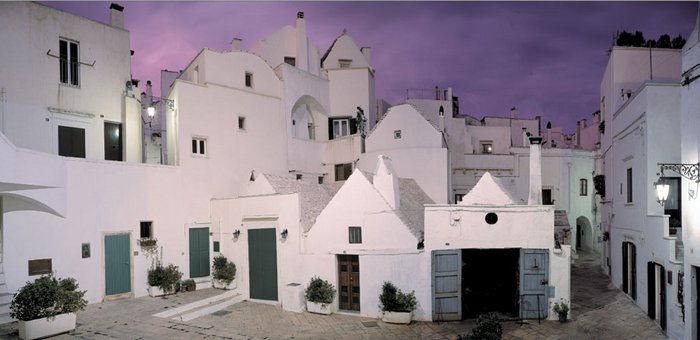 The demic center, therefore, existed and already had its own administrative autonomy where privileges to the inhabitants were issued by the feudal lord of the time, Philip I of Anjou: basically they were not obliged to pay to the bailiffs of the lands of Ostuni, Mottola and Massafra and they had the rights of grazing and watering their livestock in the territories of those cities. A few years later the hamlet was populated by different people, attracted by free grazing, a situation attested by a judicial action brought in 1315 by the University of Monopoli for the abusive occupation of its territory by the martinesi. This phenomenon induced to grant to the inhabitants of Martina a third and more important privilege, assigning on January 15, 1317 a circular territory around the urban center of roughly two miles round (Km 3,7) measuring 4,278 hectares. This area was taken from the territory of Monopoli for a fourth and the remainder by Ostuni and Taranto.
The demic center, therefore, existed and already had its own administrative autonomy where privileges to the inhabitants were issued by the feudal lord of the time, Philip I of Anjou: basically they were not obliged to pay to the bailiffs of the lands of Ostuni, Mottola and Massafra and they had the rights of grazing and watering their livestock in the territories of those cities. A few years later the hamlet was populated by different people, attracted by free grazing, a situation attested by a judicial action brought in 1315 by the University of Monopoli for the abusive occupation of its territory by the martinesi. This phenomenon induced to grant to the inhabitants of Martina a third and more important privilege, assigning on January 15, 1317 a circular territory around the urban center of roughly two miles round (Km 3,7) measuring 4,278 hectares. This area was taken from the territory of Monopoli for a fourth and the remainder by Ostuni and Taranto.
It was an extremely important concession, because in feudal times very few newly formed communities obtained their own administrative territory.
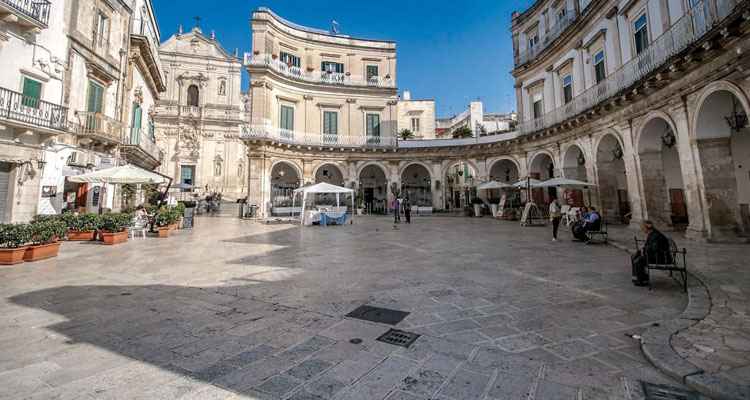 In the area, granted in allodium (private property), any Martinese, residing in the Casale, was authorized to build rural dwellings, to plant vineyards, to create vegetable gardens, to dig cisterns and to trace inter-estate roads, without being subjected to imposition of taxes of feudal nature. A subsequent concession, finally, was granted in 1359, by which Martina’s territory passed from 43 square kilometers to about 450, even if after a short time, it was reduced to its current size, about 300 square kilometers. The settlement retained the toponym until 1374, the year in which it was remembered as the land of Martina, that is, an urban center delimited by walls with towers and four gates, surrounded by ample wall moats. Nowadays the historic center looks like a continuous and imaginative maze of alleys, alleys, 'nghiostre, steep stone stairs and cunning doors and windows, a mirror of the inhabitants' dynamism and socio-economic pragmatism, which in the course of the centuries they have changed the medieval village into the Renaissance to then transform it with precious rococo decorativisms into the highest expression of the city's culture.
In the area, granted in allodium (private property), any Martinese, residing in the Casale, was authorized to build rural dwellings, to plant vineyards, to create vegetable gardens, to dig cisterns and to trace inter-estate roads, without being subjected to imposition of taxes of feudal nature. A subsequent concession, finally, was granted in 1359, by which Martina’s territory passed from 43 square kilometers to about 450, even if after a short time, it was reduced to its current size, about 300 square kilometers. The settlement retained the toponym until 1374, the year in which it was remembered as the land of Martina, that is, an urban center delimited by walls with towers and four gates, surrounded by ample wall moats. Nowadays the historic center looks like a continuous and imaginative maze of alleys, alleys, 'nghiostre, steep stone stairs and cunning doors and windows, a mirror of the inhabitants' dynamism and socio-economic pragmatism, which in the course of the centuries they have changed the medieval village into the Renaissance to then transform it with precious rococo decorativisms into the highest expression of the city's culture.
